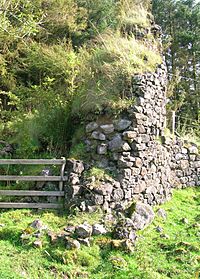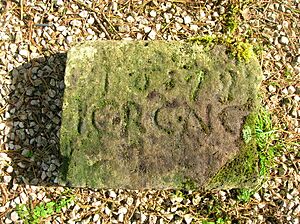Auchenbathie Tower facts for kids
Quick facts for kids Auchenbathie Tower |
|
|---|---|
| Auchenbathie, East Renfrewshire, Scotland UK |
|

The Tower of Auchenbathie Tower wall
|
|
| Coordinates | 55°46′31″N 4°33′26″W / 55.7752°N 4.5572°W |
| Type | Tower House |
| Site information | |
| Controlled by | Clan Wallace |
| Open to the public |
No |
| Condition | Part of tower wall remains |
| Site history | |
| Materials | Stone |
Auchenbathie Tower is a ruined old building in Scotland. It was once a strong tower house. The famous Clan Wallace used to own it. You can find it in a place called Renfrewshire, near Lochwinnoch. People spell its name in many ways, but "Auchenbathie" is the most common. Locals say it like "Auchenbothy".
Contents
Auchenbathie Tower's History
A special carved stone was found in an old cottage chimney nearby. It has the year 1678 on it. There are also letters "I C R C N C", which might be about the Cochrane family. In the past, in 1828, people said that a lot of the old castle was still standing.
Today, only parts of the tower walls are left. They stand about 17 feet high. A small shed for animals once stood inside the old walls. The Wallace family of Elderslie owned this tower way back in 1398.
Maps and the Tower's Location
Old maps help us learn about Auchenbathie Tower. A map from the late 1500s shows the tower looking complete. It was similar to Caldwell Tower. Later maps, like one from 1654, show it but not as a strong fort.
A map from 1747 calls the spot 'Tower'. A nearby farm was called Achinbathy. Over the years, the name changed from Auchinbathie to Auchenbathie on maps. A map from 1897 clearly marks 'Tower' where the stone wall is today.
Some people got confused about where the tower was. This was because of how the name was written on some maps. They thought a ruined farm building was the tower. But this building was probably an old smithy, a place where metal was worked.
The Wallace Family and Auchenbathie
The Wallace family is famous in Scottish history. They are known for owning Auchenbathie Tower. It was about 5 miles from their main home, Elderslie. Some people believe that Sir Malcolm Wallace, the father of the Scottish hero William Wallace, owned this land. However, William Wallace's own seal says his father's name was Alan Wallace.
Over time, the Wallaces sold parts of the Auchenbathie land. This included the tower ruins. Another part of the land was called Auchenbothie Wallace. The Wallace family line that owned this part ended around 1650.
In 1398, John Wallace of Elderslie gave the lands of Auchinbothie Wallace to his son, Thomas. Other Wallace families, like those from Ferguslie, came from this John Wallace. Other families, like the Semples and MacDowalls, also owned parts of Auchenbothie at different times.
In 1603, John Montgomery of Achinbotthy owned land nearby. He had four children. His three daughters later inherited his land.
Wallace's Knowe: A Hero's Hideout?
Wallace's Knowe is a small hill near Auchenbathie Tower. It was once a meadow in summer and a small loch in winter.
There's an old story that Sir William Wallace and his men hid here. They were said to be defending themselves from English soldiers. Many large rocks and a few trees are on this hill. Today, most of the hill is under the Barcraigs/Rowbank Reservoir. Only the highest point sticks out as a small island.
An old poem mentions: "Malcolm Walys her gat in mariage, That Ellerslie had in heritage, Auchinboth and othir sindrie places, The seocon oe he was of gude Walys."
This means: "Malcolm Wallace got in marriage, That Elderslie then had as his heritage, Auchenbothie, and sundry other places; He was the second son of good Wallace."
Auchenbathie Blair Lands
The Poll Tax Roll, a record of taxes, shows that Robert Cochrane lived in the 'Tour of Auchenbathie'. He was a weaver and a merchant. He lived with his wife Agnes and their children. Other weavers and their families also lived near the tower.
Clachan History: A Small Village
An old map from 1747 shows that this small village, or clachan, was at a crossroads. Two old roads met here. The 'castle' was simply called 'Tower'. Auchenbathie was a nearby home. Later, Tower became a farm.
The word "Auchan" or "Auchen" in place names often means a field that was recently cleared from woods. This area is one of the few places where you can still see signs of old farming fields behind the tower ruins.
The Tower Well is across from an old building that was probably a smithy. There's a story that the nearby Tower Cottage was built as a toll house. This is where people would pay to use the road.
The Fultons of Auchenbathie
The Fulton family of Auchenbathie were a branch of an older family. They are said to have moved here after losing their lands in another area.
John Fulton, who lived here, was a Jacobite. This means he supported the old royal family of Scotland. He also became rich by smuggling goods. Smuggling meant bringing goods into the country illegally to avoid taxes. These goods were often moved on horseback because the roads were bad.
In 1748, John Fulton was killed by an excise officer while smuggling. Excise officers were people who collected taxes on goods. John Fulton is buried in the churchyard of Lochwinnoch. The officer was found guilty but was later pardoned. Another story says John Fulton lost his money because he supported the Jacobites. He became very poor and died.
A nearby farm, Birdiehouse, is said to be named after smuggled Bordeaux wine. This wine was hidden there before being taken to Paisley and other places.
Later, John Love bought the lands of Auchenbathie Tower.
The Wilsons of Auchenbathie
Saunders Wilson was a weaver from Paisley. He also made illegal whisky. To do this more safely, he moved to Auchenbathie Tower. This area was known for smuggling at the time.
In 1785, Saunders and his wife Katherine had a son named Alan. Saunders had another son, Alexander, who worked as a cow herd. Alexander later became a silk weaver and a published poet in 1790.
Auchenbathie Barony
A barony was a large area of land owned by a lord. A book from the 1880s describes Auchenbathie as a barony. It says it belonged to the Wallaces of Elderslie. It also mentions that Blind Harry, a famous Scottish poet, wrote about it. He said Malcolm Wallace, William Wallace's father, owned it.
The barony was later split into two parts: Achinbathie Blair and Achinbathie Wallace. The farm of Nethertrees was part of the barony. Wallace's Knowe was also on these lands. The Stewarts of Blackhall later bought the Auchenbathie Wallace barony.
Barony Mill
Old maps show a mill called Neu Mil, which was the barony mill. A map from 1832 shows the New Mill with a large mill pond. This mill was known as the Newmiln of Auchengown. The King family owned it until about 1726. It is even said that Rob Roy MacGregor, a famous Scottish outlaw, used the mill as a hiding place.
Auchenbathie Burn
The Auchenbathie Burn is a small river. It flows for about 4 miles along the border with Beith. It ends at the head of Castle Semple Loch. Another burn, the Muirhead Burn, flows near the tower and farm.
Images for kids








